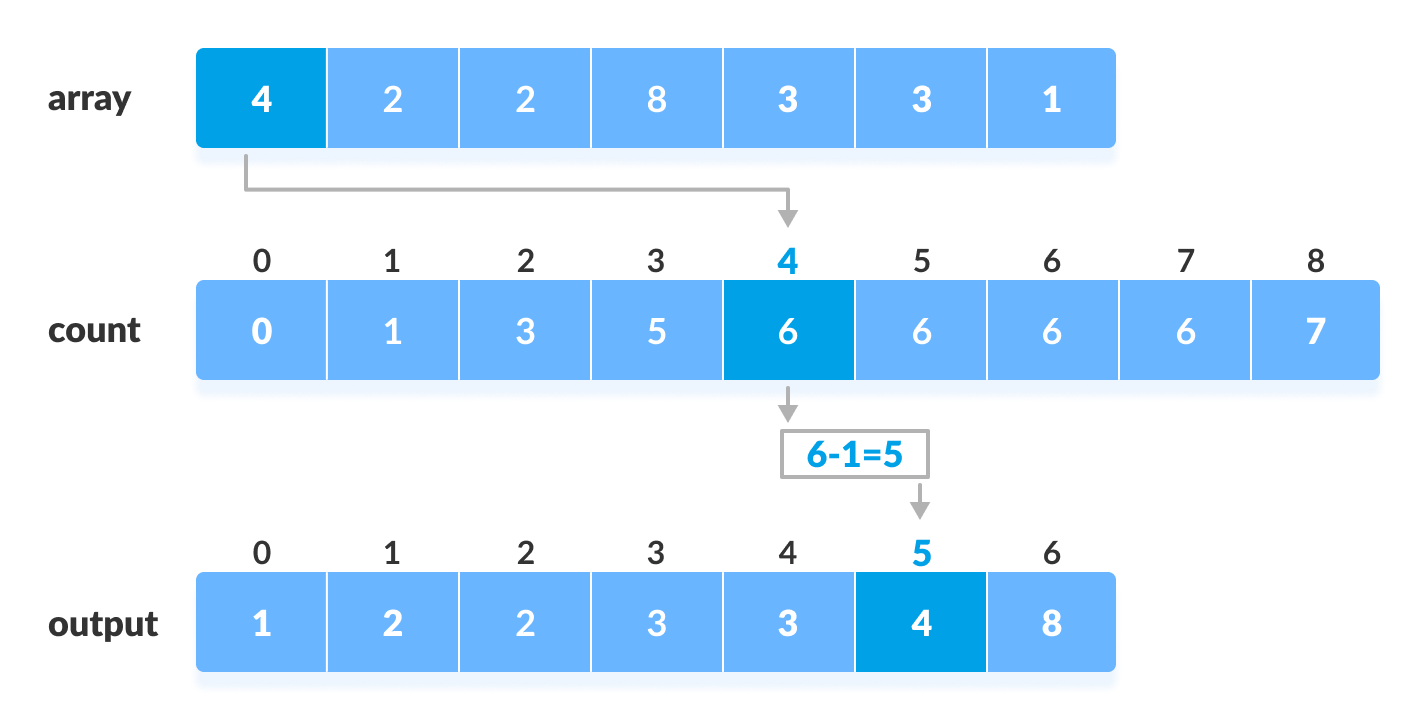Count Sort
Stable sort. Count occurrences of each unique element in array and stores it in an auxiliary array. Then calculate the cumulative sum of the elements of the count array. Use the cumulative sum to place the numbers in the correct position.

note
Count sort is only really viable, time complexity less than O() if the length of the frequency map used is bounded by O()
Implementation
Unstable version (without cumulative sum), works only for integers
# Saves space but doing lots of addition/subtraction
def counting_sort(nums):
min_val = math.inf
max_val = -math.inf
for val in nums:
if val < min_val:
min_val = val
if val > max_val:
max_val = val
sz = max_val - min_val + 1
b = [0] * sz
for i in range(len(nums)):
b[nums[i] - min_val] += 1
k = 0
for i in range(sz):
while b[i] > 0:
b[i] -= 1
nums[k] = i + min_val
k += 1
# if min_val is low
def count_sort(nums):
n = len(nums)
# b = buckets of nums
b = [0] * (max(n)+1)
# store count
for i in range(n):
b[nums[i]] += 1
k = 0
for i in range(max(n)+1):
while b[i] > 0:
b[i] -= 1
nums[k] = nums[i]
k += 1
Stable version (uses cumulative sum, useful when items sorted are not just integers)
- This version is stable because we iterate the unsorted array backwards, check its position in the sorted array according to the counts array, and copy it to the sorted array
- The counts array is not used to tell how many times an integer appears in the unsorted array, instead, it is used to tell which position the element should be in the final sorted array. And since we decrease the count every time we output an element, we are essentially making the elements with same key’s next appearance final position smaller. That’s why we need to iterate the unsorted array from backwards to ensure its stableness. (https://stackoverflow.com/questions/2572195/how-is-counting-sort-a-stable-sort)
def counting_sort(nums):
n = len(nums)
k = max(nums) + 1
count = [0] * k
output = [0] * n
# store count
for i in range(n):
count[nums[i]] += 1
# store cumulative count
for i in range(1,k):
count[i] += count[i-1]
# place nums backwards to ensure stableness
for num in reversed(nums):
# count[num] -=1 first because this stores the count but the index of the output is 0-based
count[num] -= 1
output[count[num]] = num
return outputAccounting for negative numbers
count = [0] * max_val - min_val + 1
count[nums[i] - min_val] += 1
def counting_sort(nums):
n = len(nums)
min_val = min(nums)
k = max(nums) - min_val + 1
count = [0] * k
output = [0]* n
# store count
for num in enumerate(nums):
count[num - min_val] += 1
# store cumulative count
for i in range(1,k):
count[i] += count[i-1]
# place nums backwards
for num in reversed(nums):
count[num-min_val] -= 1
output[count[num-min_val]] = num
return outputTime/Space Complexity
- Count sort is only linear in time complexity if is O(), where is the length of the frequency map
- Space Complexity is: O( + max_val - min_val) https://stackoverflow.com/questions/27668792/why-is-counting-sort-not-used-for-large-inputs
Frequency Map/Counting Problems
- Count frequency of all elements
- Loop starting from min num and increment
freq[i]
Minimum Increment to Make Array Unique
https://leetcode.com/problems/minimum-increment-to-make-array-unique/description/
- Frequency map of all elements
- Increment duplicates repeatedly until count is 1 for that specific num
def minIncrementForUnique(self, nums: List[int]) -> int:
n = len(nums)
mx = max(nums)
res = 0
freq = [0]*(n+mx+1)
for x in nums:
freq[x] += 1
for i in range(len(freq)):
if freq[i] <= 1:
continue
freq[i+1] += freq[i]-1
res += freq[i]-1
return resMaximum Product After K Increments
- Greedily increment the smallest elements
def maximumProduct(self, nums: List[int], k: int) -> int:
freq = Counter(nums)
i = min(nums)
while k > 0:
ops = min(k, freq[i])
freq[i] -= ops
k -= ops
freq[i+1] += ops
if not freq[i]:
del freq[i]
i += 1
res = 1
for k in freq:
for i in range(freq[k]):
res = (res*k%(10**9+7))
return res